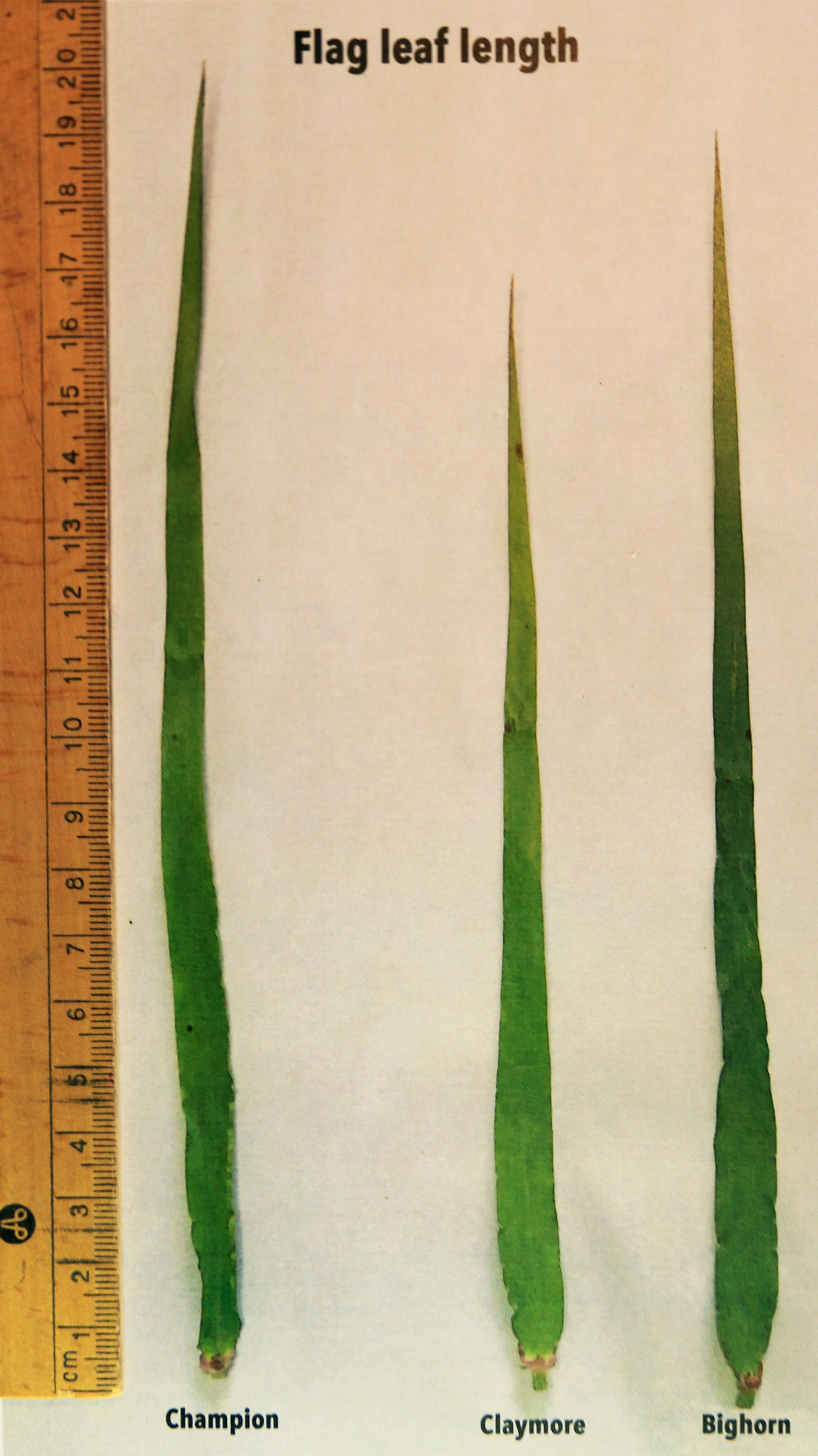Bighorn
| Denomination: | 'Bighorn' |
|---|---|
| Botanical Name: | Hordeum vulgare |
| Applicant/Holder: |
Highland Specialty Grains 39355 Sorensen Rd. N. Almira, Washington 99103 United States of America |
| Breeder: |
Highland Specialty Grains, Almira, United States of America |
| Agent in Canada: |
Nutrien Ag Solutions (Canada) Inc. 10639 Barlow Trail SE Calgary, Alberta T2C 4M5 Canada Tel: 403.652.8973 |
| Application Date: | 2022-04-19 |
| Provisional Protection:: | 2022-04-19 |
| Application Number: | 22-10883 |
| Grant of Rights Date: | 2023-11-07 |
| Certificate Number: | 6944 |
| Grant of Rights Termination Date: | 2043-11-07 |
Variety Description
Varieties used for comparison: 'Champion' and 'Claymore'
Summary: At tillering, the pubescence on the lower leaf sheath of 'Bighorn' is sparse while pubescence is absent or very sparse on the lower leaf sheath of 'Champion'. At booting, anthocyanin colouration is absent on the flag leaf auricles of 'Bighorn' while it is present on the flag leaf auricles of 'Champion' and 'Claymore'. The flag leaf of 'Bighorn' is longer than the flag leaf of 'Claymore'. At the soft dough stage, the anthocyanin colouration of the nerves of lemma on the kernel of 'Bighorn' is of an absent or very weak to weak intensity while it is of a medium intensity for 'Champion'. At the beginning of ripening, the spike of 'Bighorn' is lax while the spike of 'Champion' is of a medium density. The glume and awn of the median spikelet for 'Bighorn' are equal in length relative to the grain while the glume and awn of the median spikelet for 'Champion' are longer than the grain. The spiculation of the inner lateral nerves on the dorsal side of the lemma on the kernel of 'Bighorn' is medium to strong while that of 'Champion' is weak to medium and that of 'Claymore' is weak. The kernel of 'Bighorn' is wider than the kernel of 'Champion'.
Description:
YOUNG PLANT: erect growth habit at tillering, sparse pubescence on lower leaf sheaths
PLANT: two row, spring feed barley
AURICLES: no anthocyanin colouration, absent or very sparse pubescence on margins
SPIKE: mid-season emergence, medium to strong glaucosity at end of anthesis, semi-erect attitude, platform shaped collar, tapering to parallel shape, lax, parallel to weakly divergent sterile spikelet attitude, glume and awn of the median spikelet are equal in length relative to the grain
LEMMA AWNS: very weak intensity of anthocyanin colouration of tips, longer than spike, rough spiculations on margins
FIRST SEGMENT OF RACHIS: short, medium to strong curvature
KERNEL: absent or very weak to weak intensity of anthocyanin colouration of nerves of lemma, whitish aleurone layer, short rachilla hairs, husk absent, medium to strong spiculation of inner lateral nerves of dorsal side of lemma, hairless ventral furrow, horseshoe shaped basal markings, long and wide
AGRONOMIC CHARACTERISTICS: fair to good resistance to lodging, good resistance to shattering, good tolerance to straw breakage, fair to good tolerance to drought
Origin & Breeding History: 'Bighorn' (experimental designations H0516-388 and TR18748) originated from a cross conducted by Highland Specialty Grains between the varieties 'Claymore' and 'Champion' in Casa Grand, Arizona, USA in March, 2014. The F1 seed was bulk harvested in May, 2014 and planted in Gilroy, California, USA. Subsequent selections were made based on seed plumpness, standability and favourable plant type, from the F2 to F4 generations in Gilroy, California, Holtville, California and Moses Lake, Washington respectively. One F5 head row, designated as H0516-388, that satisfied criteria for standability, uniformity and tillering, was selected and planted in replicated trials in Alberta, Canada in 2016 and in Alberta and Saskatchewan, Canada in 2017. The variety was tested in The Western Cooperative Two-Row Barley Registration Trials as 'TR18748' in 2018 and 2019. In 2020, F10 heads were selected and planted in head rows near Yuma, Arizona. A single F11 headrow was selected based on uniformity, and planted as strips near Moses Lake, Washington, USA. Resulting F12 strips that appeared uniform were bulk harvested as breeder seed in 2021.
Tests & Trials: The comparative trials for 'Bighorn' were conducted in Neapolis, Alberta during the 2021 and 2022 growing seasons. There were 3 row blocks each consisting of 3 replicates per variety with the second and third row blocks arranged in a RCB design. The individual plots consisted of 5 rows, 5 metres in length, with 0.25m inter-row spacing and 0.45m spacing between the plots. The seeding density was 275 seeds per square metre resulting in 13,500 plants per variety per year. Measured characteristics were based on a minimum of 20 measurements. Mean differences were significant at the 5% probability level based on a paired Student's T-test.
Comparison tables for 'Bighorn' with reference varieties 'Champion' and 'Claymore'
Flag leaf length (cm)
| 'Bighorn' | 'Champion' | 'Claymore' | |
|---|---|---|---|
| mean 2021 | 16.2 | 19.1 | 13.7 |
| std. deviation 2021 | 1.49 | 1.23 | 1.41 |
| mean 2022 | 19.7 | 17.4 | 16.4 |
| std. deviation 2022 | 1.68 | 1.65 | 1.60 |
Kernel width (mm)
| 'Bighorn' | 'Champion' | 'Claymore' | |
|---|---|---|---|
| mean 2021 | 3.9 | 3.6 | 3.6 |
| std. deviation 2021 | 0.33 | 0.49 | 0.49 |
| mean 2022 | 4.1 | 3.9 | 4.0 |
| std. deviation 2022 | 0.30 | 0.27 | 0.25 |
Click on image for larger view

Barley: 'Bighorn' (right) with reference varieties 'Champion' (left) and 'Claymore' (centre)
Click on image for larger view

Barley: 'Bighorn' (right) with reference varieties 'Champion' (left) and 'Claymore' (centre)
- Date modified: